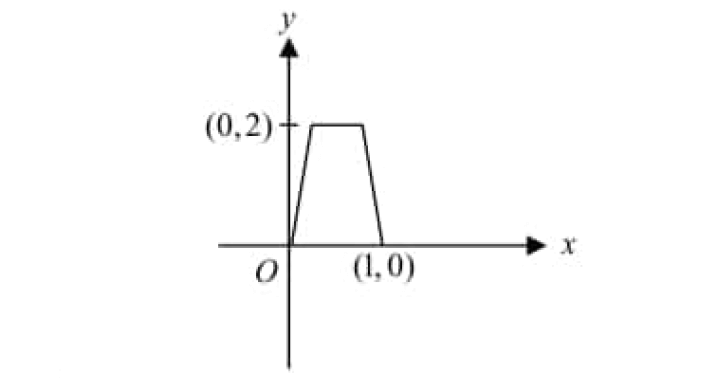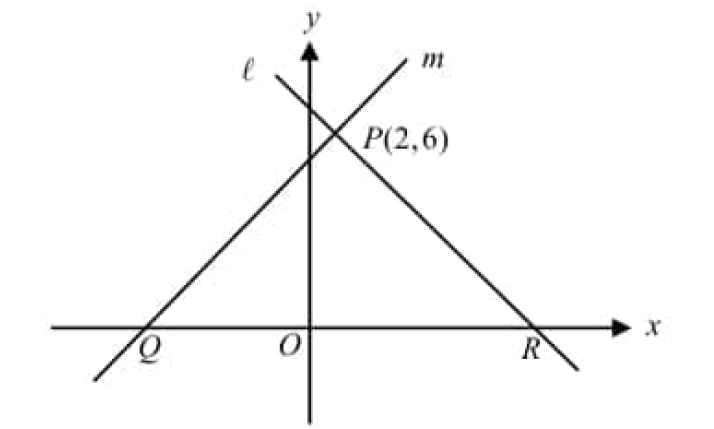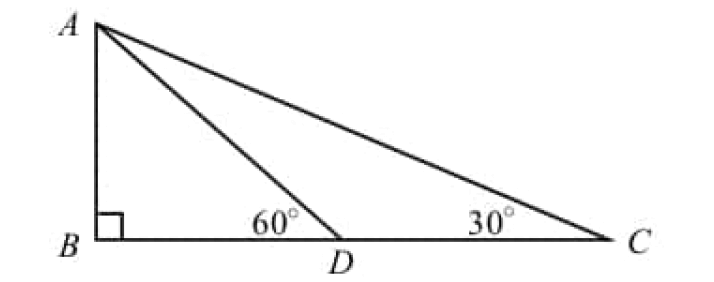PROBLEMS ON INTERSECTING LINES
Example 1 :
If x + 2y = 7 and 2x + y = 8 are the equations of the lines of two diameter of the circle, find the radius of the circle if the point (0, -2) lies on the circle.
Solution :
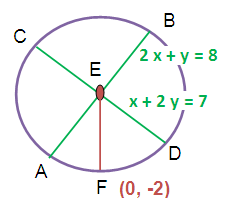
Two diameters are intersecting at the point E
x + 2y = 7 ----(1)
2x + y = 8 ----(2)
2(1) - (2) :
2(x + 2y) - (2x + y) = 14 - 8
2x + 4y - 2x - y = 6
3y = 6
y = 2
Substitute y = 2 in (1).
x + 2(2) = 7
x + 4 = 7
x = 7 - 4
x = 3
Diameters are intersecting at the point E (3, 2).
So, center of the circle is E(3, 2).
To find radius, find the distance between the points F and E.
d = √[(x2 - x1)2 + (y2 - y1)2]
Substitute (x1, y1) = E(3, 2) and (x2, y2) = F(0, -2).
= √[(0 - 3)2 + (-2 - 2)2]
= √(9 + 16)
= √25
= 5
Radius of the circle is 5 units.
Example 2 :
Find the equation of the straight line segment whose end points are the point of intersection of the straight lines
2x – 3y + 4 = 0, x – 2y + 3 = 0
and the midpoint of the line joining (3, -2) and (-5, 8).
Solution :
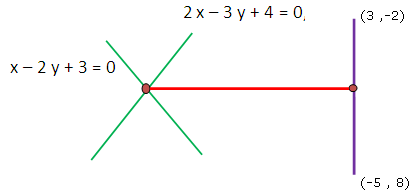
2x – 3y + 4 = 0 ----(1)
x – 2y + 3 = 0 ----(2)
Let A be the point of intersection of (1) and (2) and B be the midpoint of the line joining (3, -2) and (-5, 8).
Target : Find the equation of the line AB.
(1) - 2(2) :
2x - 3y + 4 - 2(x - 2y + 3) = 0
2x - 3y + 4 - 2x + 4y - 6 = 0
y - 2 = 0
y = 2
Substitute y = 2 in (1).
2x - 3(2) + 4 = 0
2x - 6 + 4 = 0
2x - 2 = 0
x = 1
Point of intersection of the lines (1) and (2) is A(1, 2).
Find the midpoint of line joining (3, -2) and (-5, 8).
Midpoint = ((x1 + x2)/2, (y1 + y2)/2)
= ((3 - 5)/2, (-2 + 8)/2)
= (-2/2, 6/2)
= B(-1, 3)
Find the slope of the line AB :
m = (y2 - y1)/(x2 - x1)
Substitute (x1, y1) = A(1, 2) and (x2, y2) = B(-1, 3).
m = (3 - 2)/(-1 - 1)
= 1/(-2)
= -1/2
Equation of the line AB :
y - y1 = m(x - x1)
Substitute (x1, y1) = A(1, 2) and m = -1/2.
y - 2 = (-1/2)(x - 1)
2(y - 2) = -1(x - 1)
2y - 4 = -x + 1
x + 2y - 5 = 0
Example 3 :
If the isosceles triangle PQR, PQ = PR. The base QR lies on the axis, P lies on the y-axis and
2x – 3y + 9 = 0
is the equation of PQ. Find the equation of PQ. Find the equation of the straight line along PR.
Solution :
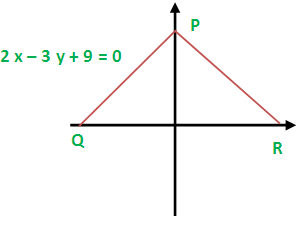
To find the point point P which lies on the y-axis, substitute x = 0.
2(0) - 3y = -9
-3y = -9
y = 3
The point P is (0, 3)
To find the point point Q which lies on the x-axis, substitute y = 0.
2x - 3(0) = -9
2x - 0 = -9
2x = -9
x = -9/2
The point Q is (-9/2 , 0)
The length of the sides PQ and PR are same. So the point R is (9/2,0)
Equation of PR :
(y-y1)/(y2-y1) = (x-x1)/(x2-x1)
Substitute (x1, y1) = P(3, 0) and (x2, y2) = R(9/2, 0).
(y - 3)/(0 - 3) = (x - 9/2)/(9/2 - 3)
(y - 3)/(-3) = (2x - 9)/(3/2)
-(y - 3) = 2(2x - 9)
- y + 3 = 4x - 18
4x + y - 21 = 0
Example 4 :
Find the equation of a straight line parallel to Y axis and passing through the point of intersection of the lines 4x + 5y = 13 and x - 8y + 9 = 0
Solution :
To find the point of intersection of these two lines
4x + 5y = 13 --------(1)
x - 8y + 9 = 0 --------(2)
(2) ⋅ (-4) ==> 4x + 5y = 13
-4x + 32y = 36
-----------------
37y = 49
y = 49/37
Applying the value of y in (1), we get
4x + 5(49/37) = 13
4x = 13 - (245/37)
4x = (481 - 245)/37
= 236/37
x = 236/37(4)
x = 59/37
Since the required line is parallel to y-axis, the slope will become 0.
y - y1 = m(x - x1)
y - 49/37 = (1/0)(x - 59/37)
0 = x - 59/37
37x - 59 = 0
Example 5 :
Find the equation of a straight line through the intersection of lines 7x + 3y = 10, 5x - 4y = 1 and parallel to the line 13x + 5y + 12 = 0
Solution :
7x + 3y = 10 ------(1)
5x - 4y = 1 -------(2)
(1) ⋅ 4 ==> 28x + 12y = 40
(2) ⋅ 3 ==> 15x - 12y = 3
----------------
43x = 43
x = 43/43
x = 1
Applying x = 1 in (1), we get
7(1) + 3y = 10
7 + 3y = 10
3y = 10 - 7
3y = 3
y = 1
So, the point of intersection is at (1, 1).
The required line is parallel to 13x + 5y + 12 = 0
5y = -13x - 12
y = (-13/5)x - (12/5)
Slope = -13/5
Equation of line :
(y - y1) = m(x - x1)
y - 1 = -13/5 (x - 1)
5(y - 1) = -13(x - 1)
5y - 5 = -13x + 13
13x + 5y - 5 - 13 = 0
13x + 5y - 18 = 0
So, the required equation is 13x + 5y - 18 = 0.
Kindly mail your feedback to v4formath@gmail.com
We always appreciate your feedback.
©All rights reserved. onlinemath4all.com
Recent Articles
-
Digital SAT Math Problems and Solutions (Part - 213)
Jul 13, 25 09:51 AM
Digital SAT Math Problems and Solutions (Part - 213) -
Digital SAT Math Problems and Solutions (Part - 212)
Jul 13, 25 09:32 AM
Digital SAT Math Problems and Solutions (Part - 212) -
Digital SAT Math Problems and Solutions (Part - 211)
Jul 11, 25 08:34 AM
Digital SAT Math Problems and Solutions (Part - 211)
